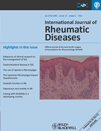The prevalence of rheumatoid factor isotypes and anti-cyclic citrullinated peptides in Malaysian rheumatoid arthritis patients
Abstract
Aim: The purpose of this study is to compare the prevalence of rheumatoid factor (RF) isotypes and second generation anti-cyclic citrullinated peptides (anti-CCP) in Malaysian rheumatoid arthritis (RA) patients.
Methods: In this cross-sectional study, 147 established RA patients from three ethnic groups were recruited from a major rheumatology clinic in Malaysia. Enzyme-linked immunosorbent assays (ELISA) for serum RF isotypes IgA, IgG and IgM as well as second-generation anti-CCP were performed and the prevalence of each auto-antibody was compared in the three ethnic groups.
Results: The anti-CCP was the most prevalent auto-antibody in each of the ethnic groups, followed closely by RF IgM and RF IgG. Rheumatoid factor IgA was the least prevalent across all three ethnic groups. The anti-CCP–RF IgM combination provided the best test sensitivity. Seroprevalence of anti-CCP was strongly associated with the presence of each of the RF isotypes. The seroprevalence of RF and anti-CCP did not increase or decrease with advancing age, age at onset and disease duration.
Conclusion: When used alone, anti-CCP provides a diagnostic advantage over RF IgM on the basis of test sensitivity. Considering the high cost of the anti-CCP assay, step-wise serum testing with IgM RF followed by anti-CCP may provide a more economically sensible option to optimize test sensitivity for RA.




